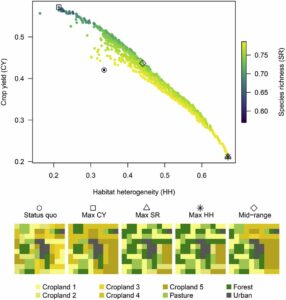Land is a spare resource so it makes sense to think about how to use it most efficiently. This leads to the problem of land use allocation under consideration of trade-offs. Multi-objective optimization algorithms are a tool quantify the trade-offs by estimating the Pareto-optimal land use allocations. Often, constraints in the solution space have to be incorporated in land use optimization approaches: most frequently, the amount of land use change allowed or transitions between land use classes is restricted. A group of scientist – involving GIScience/HeiGIT member – Sven Lautenbach has published a python library for constraint handling in land use optimization. Two options have been implemented for constraint handling: penalization or use of repair mechanism. Testing both options on virtual test data showed that the repair mechanism for constraint handling outperformed the approach based on penalization. The test data represent a virtual landscape, the control variables represent land use at patch level and the objective function consists of crop yield, forest species richness, habitat heterogeneity and water yield.
optimization run using repair mutation considering both transition and area
rules compared to the status quo land use with illustration of extreme and mid-
range solutions. Max CY is the solution with maximal crop yield, Max SR the
solution with maximal species richness and Max HH the solution with maximal
habitat heterogeneity. Values were normalized by the theoretical (un-
constrained) optimum values for each objective.
Strauch, Michael, Anna F. Cord, Carola Pätzold, Sven Lautenbach, Andrea Kaim, Christian Schweitzer, Ralf Seppelt, und Martin Volk. „Constraints in Multi-Objective Optimization of Land Use Allocation – Repair or Penalize?“ Environmental Modelling & Software, Mai 2019. https://doi.org/10.1016/j.envsoft.2019.05.003.



